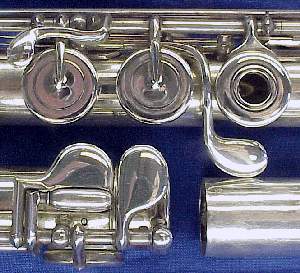William S. Haynes
Serial # 18530; Boston; 1947; soldered silver
thinwall body
& mechanism; sl 596mm; A=442-444; 371g; .010"h .011"b
In an effort to reproduce the coveted "early French" sound of the Louis Lot flutes, Laurent had Haynes make a series of flutes to his specification in direct imitation of the 19th century French masters, with C foot and open holes. (As Rampal said, "Real flutes have C foots.") But by far the most difficult specification was for a very thin silver body wall thickness.





 Thanks
to Jim Calabrese, Alan Weiss, Phillip Kaplan, John Levine and Marjorie
Bollinger for helping me learn more about the historical development of
this flute!
Thanks
to Jim Calabrese, Alan Weiss, Phillip Kaplan, John Levine and Marjorie
Bollinger for helping me learn more about the historical development of
this flute!